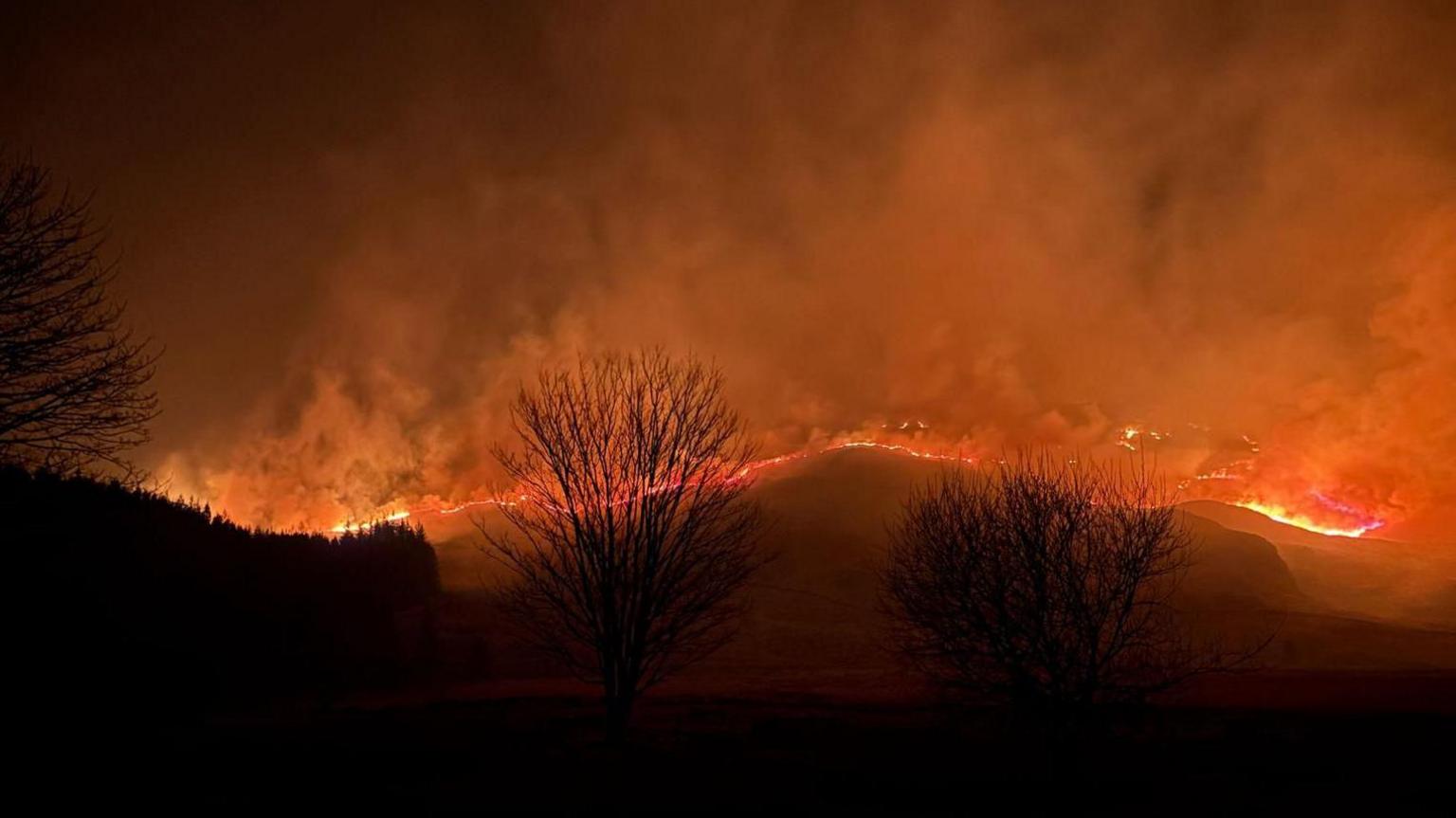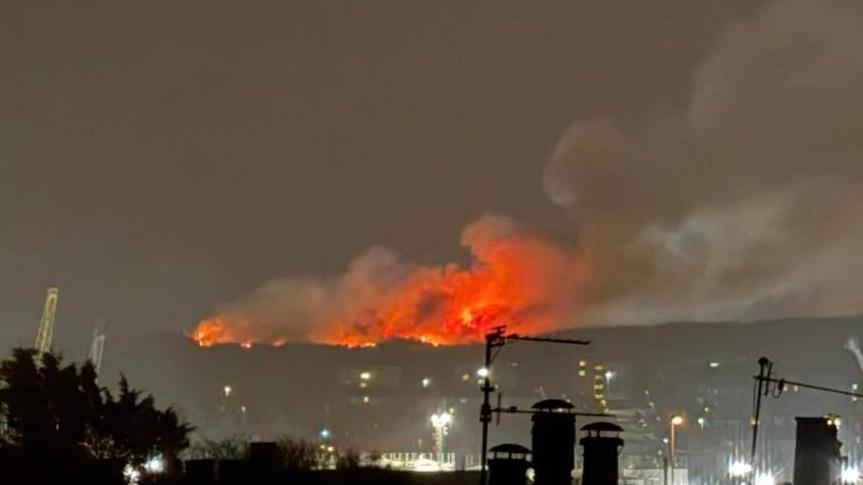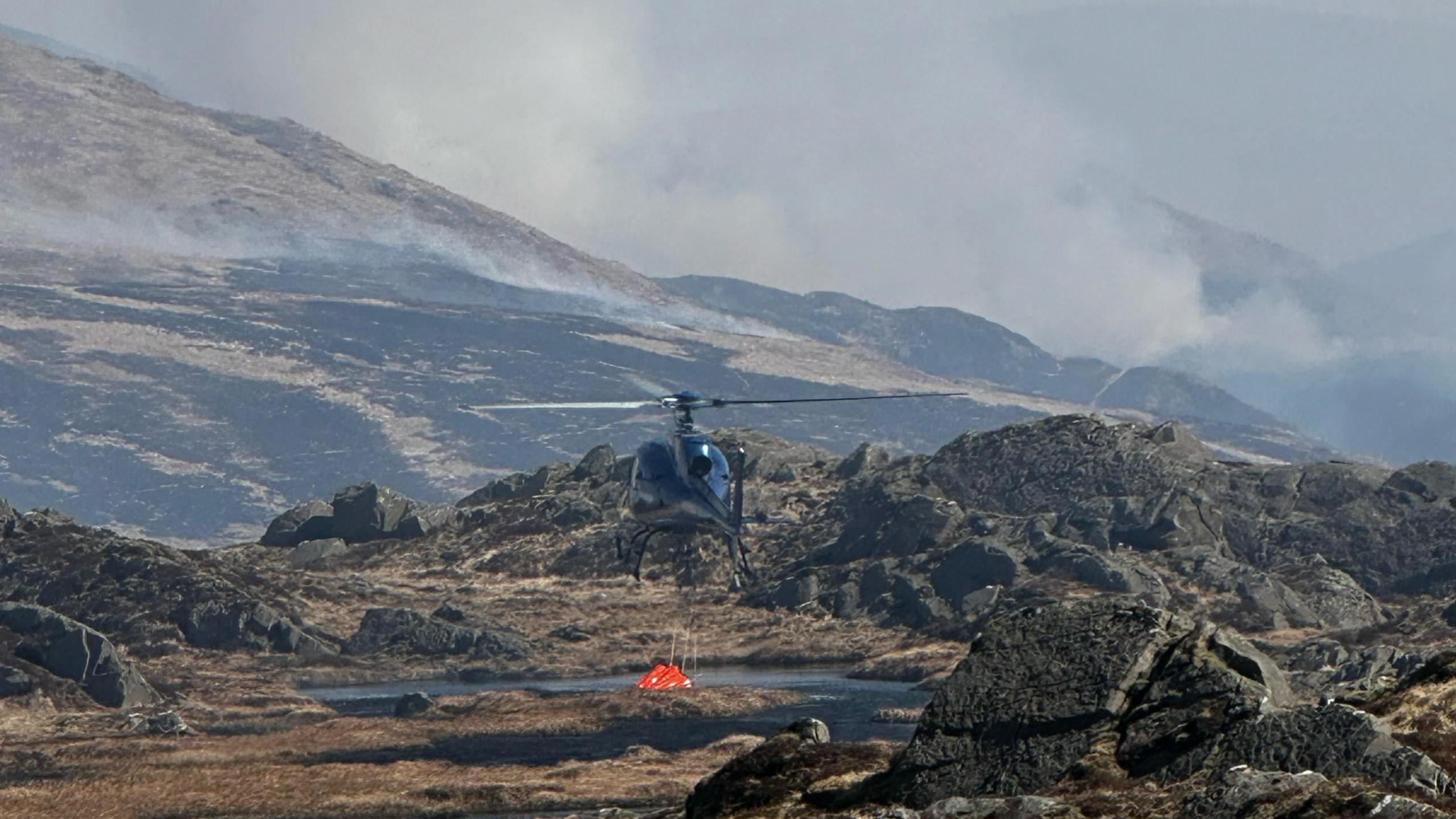Firefighters tackle third hillside wildfire

Huge plumes of smoke could be seen over a forest near Inverkip
- Published
Firefighters have tackled a wildfire which broke out on a hillside in Inverclyde.
Huge plumes of smoke could be seen billowing over a forest near Inverkip on Monday night.
The Scottish Fire and Rescue Service said it had sent a single engine and its crew to put out the blaze.
Meanwhile, fire crews spent another day at the scene of two wildfires that were burning over the weekend in parts of Scotland.

Wildfires continued to burn in the Galloway hills over the weekend.
A blaze began in the Glen Trool area of the Galloway Forest Park on Thursday, which then spread to Loch Doon in East Ayrshire.
The Scottish government said the fire was now "under control", after its resilience room met on Sunday evening.
Meanwhile, in the Highlands Scottish Fire and Rescue Service (SFRS) crews have been tackling a wildfire in Stac Pollaidh, at Inverpolly Forest near Ullapool.
SFRS said the Stac Pollaidh fire had been put out by 19:30, but the situation would be monitored overnight before crews return to check in the morning.
Justice Secretary Angela Constance, praised emergency services for their work at the Galloway blaze.
"I am extremely grateful to all the first responders who have been working hard to control this fire," she said.
"I am reassured to hear that so far there has been no damage to properties or mature woodland."
Helicopters had been deployed to water-bomb the fire over the weekend.
Five groups of walkers were located on the hills on Friday night, but were moved away from the area.

The Galloway blaze took hold on Thursday and spread north over the weekend
Among those rescued were Bruce Marbrow and his son Jack, 13, who had travelled from Yorkshire for a trip with friend Scott Rayner and his son Frankie, 13, to camp in Galloway Forest Park.
When they saw smoke in the distance, the campers attributed it to the controlled burning of heather, not realising the flames were from a wildfire, The Scotsman newspaper reported, external.
Mr Marbrow told The Scotsman the fire was a "proper inferno" about 20m (66ft) away from where they intended to camp.
They were rescued at about 04:00 on Saturday by the HM Coastguard search and rescue helicopter.
Police Scotland said on Monday afternoon a number of areas were still affected, including Merrick, Millmore and Macaterick, and that the public should continue to avoid affected areas.
A fire engine remained at the scene overnight on Sunday, while another was despatched on Monday morning.

A wildfire broke out in woodland at Stac Pollaidh near Ullapool
In the Highlands, five fire engines were at the scene of the blaze on Monday and people have been advised to stay away from the area.
The A835, which was closed at the junction for Achiltibuie and the junction for Badnagyle due to the wildfire, has now re-opened.
Rising temperatures across the UK have led to wildfire warnings being put in place for several parts of the country.
Together with the Scottish Wildfire Forum, the SFRS urged people to avoid lighting fires outdoors across all areas of Scotland.
Ms Constance added: "As we continue to see a period of warm and dry weather, it's essential that all of us act responsibly while enjoying the outdoors so we can keep the number of wildfires at an absolute minimum."
What causes wildfires?

Fire crews from Balintore tackled a wildfire in the Highlands last month
Stuart Gibson, a team leader with Galloway Mountain Rescue Team, told BBC Radio's Good Morning Scotland programme there are many reasons a wildfire can start.
He said: "It can be people lighting campfires, it can be disposable barbeques, cigarettes - we would urge anyone going out into the hills to be really careful."
Mr Gibson added that a dry winter and an "exceptionally" dry past couple of weeks meant there was a lot of dry deadwood, that could be set on fire quickly.
The BBC weather service found that the the south of Scotland had only recorded about 30%-50% of its expected rainfall for March.
Get in touch
Have you been affected by Scotland's wildfires?
SFRS guidance, external suggests taking care with glass bottles as well, as they can act like a magnifying glass when sunlight shines through them.
That can then focus heat and ignite dry materials nearby, causing a fire.
The combination of new growth and typically drier ground make spring a time with conditions well-suited to fires starting.
Previous analysis by the fire service showed around two thirds of wildfires are accidental - the most common causes recorded were discarded cigarettes or unattended campfires.
What impact do wildfires have?
The Scottish Wildfire Forum says the impact of wildfires on Scotland's natural environment can be "devastating".
Smoke from wildfires can reduce air quality, affecting the health of people living nearby, while the wider environment can be hit by the loss of habitat or the loss of carbon storage and carbon emissions.
Environmental reesearch by the James Hutton Institute, external found that it can take many years for plants and vegetation to return their pre-fire state, particularly in areas with dry heath, like moorlands.
In addition, wildfires take up considerable resources from the fire service, with a knock-on effect on the time devoted to responding to incidents elsewhere.

Sign up for our Future Earth newsletter to keep up with the latest climate and environment stories with the BBC's Justin Rowlatt. Outside the UK? Sign up to our international newsletter here.
- Published5 April

- Published6 April
